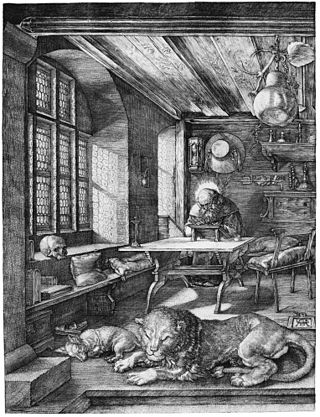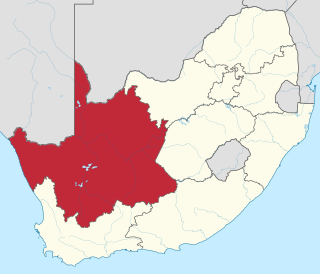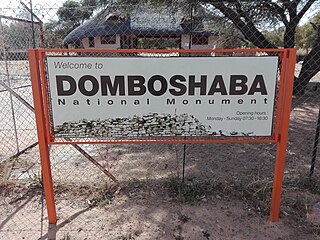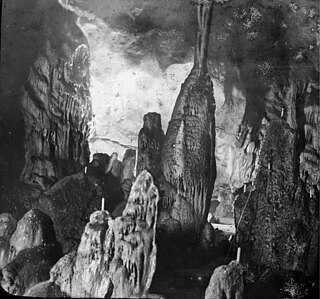Related Research Articles

Botswana, officially the Republic of Botswana, is a landlocked country in Southern Africa. Botswana is topographically flat, with approximately 70 per cent of its territory being the Kalahari Desert. It is bordered by South Africa to the south and southeast, Namibia to the west and north, and Zimbabwe to the northeast. It is connected by the Kazungula Bridge to Zambia, across the world's shortest border between two countries.

Botswana is a landlocked country located in Southern Africa, north of South Africa. Botswana occupies an area of 581,730 square kilometres (224,610 sq mi), of which 566,730 km2 (218,820 sq mi) are land. Botswana has land boundaries of combined length 4,347.15 kilometres (2,701.19 mi), of which the constituent boundaries are shared with Namibia, for 1,544 km (959 mi); South Africa 1,969 km (1,223 mi); Zimbabwe, 834 km (518 mi) and Zambia, 0.15 km (0.093 mi). Much of the population of Botswana is concentrated in the eastern part of the country.

Transportation in Botswana is provided by an extensive network of railways, highways, ferry services and air routes that criss-cross the country. The transport sector in Botswana played an important role in economic growth following its independence in 1966. The country discovered natural resources which allowed it to finance the development of infrastructure, and policy ensured that the transport sector grew at an affordable pace commensurate with demands for services.

Gaborone is the capital and largest city of Botswana with a population of 246,325 based on the 2022 census, about 10% of the total population of Botswana. Its agglomeration is home to 421,907 inhabitants at the 2011 census.

Engraving is the practice of incising a design onto a hard, usually flat surface by cutting grooves into it with a burin. The result may be a decorated object in itself, as when silver, gold, steel, or glass are engraved, or may provide an intaglio printing plate, of copper or another metal, for printing images on paper as prints or illustrations; these images are also called "engravings". Engraving is one of the oldest and most important techniques in printmaking.

Giovanni BattistaPiranesi was an Italian classical archaeologist, architect, and artist, famous for his etchings of Rome and of fictitious and atmospheric "prisons". He was the father of Francesco Piranesi, Laura Piranesi and Pietro Piranesi.

The Northern Cape is the largest and most sparsely populated province of South Africa. It was created in 1994 when the Cape Province was split up. Its capital is Kimberley. It includes the Kalahari Gemsbok National Park, part of the Kgalagadi Transfrontier Park and an international park shared with Botswana. It also includes the Augrabies Falls and the diamond mining regions in Kimberley and Alexander Bay.

Molepolole is a large village in Kweneng District, Botswana.

Ghanzi is a town in the middle of the Kalahari Desert the western part of the Republic of Botswana in southern Africa. The region is the country's pride in contributing a large portion towards the beef industry. In fact, Ghanzi farmers provide about 75% percent of beef exports, according to the Botswana Meat Commission, primarily to the United Kingdom and the European Union.

The North-West District or Ngamiland is one of the first-level administrative subdivisions of Botswana. For census and administrative purposes Ngamiland is subdivided into Ngamiland East, Ngamiland West and Ngamiland Delta (Okavango). It is governed by a District Commissioner, appointed by the national government, and the elected North-West District Council. The administrative centre is Maun.
A quadripoint is a point on Earth where four distinct political territories meet. The territories can be of different types, such as national and provincial. In North America, several such places are commonly known as Four Corners. Several examples exist throughout the world that use other names.
Osire is a refugee camp in central Namibia, situated 200 km north of the capital Windhoek next to the main road C30 from Gobabis to Otjiwarongo. It was established in 1992 to accommodate refugees from Angola, Burundi, the Democratic Republic of the Congo, Rwanda and Somalia. The camp grew quickly in its early years, reaching a peak of 20,000 inhabitants in 1998. Since then the refugee population of Osire decreased steadily, approaching 6,500 in 2010, and 3,000 in 2014. Due to the cessation of conflicts in the countries where inhabitants originate from, the camp is scheduled to close. In 2008 the majority (75%) of refugees still resident here came from Angola, and a sizeable portion from the Democratic Republic of the Congo. UNHCR regards the camp as one of the best managed in the world, due to its provisioning of formal school education, both primary and secondary. The settlement further has a police station and a clinic.
Alexander Colin Campbell was an archaeologist and museum curator in Botswana. He was Emeritus Director of Botswana's Department of Wildlife and National Parks and National Monuments.

Botswana's most popular landmarks range from a group of large baobab trees to giant-size footprints fossilized in the rock. Other natural attractions include expanses of salt flats, the Kalahari desert and some very beautiful mountains.

The Caves of Gargas in the Pyrenees region of France are known for their cave art from the Upper Paleolithic period - about 27,000 years old.

Gcwihaba is a cave in Botswana located in Okavango Delta region. The Gcwihaba Caves were part of the Kalahari landscape around 2 million years ago, at least for the entire period of the Pleistocene. The name of the cave is a San word and stands for "hyena's lair". The cave is situated 10 km away from the Namibian border. In 1932 it was first shown to a European, Ghanzi region farmer Martinus Drotsky, and the main cavern was named Drotsky's cavern after him.

Domboshaba ruins is a cultural and heritage site in Botswana originally occupied towards the end of the Great Zimbabwe period. The site is a respected place for the people living in the region and it is believed that the chief lived on the top of the hill together with his helpers or assistants.
Setapa is a traditional music dance which originates from the Bangwaketse tribe of Kanye village and surrounding areas in Botswana, such as Sesung, Selokolela and Molapo wa Basadi villages. Setapa traditional dance was started by Bangwaketse in the past and therefore it is regarded as the dance for the tribe. Setapa involves a group of people stamping in to the ground with their feet to the song played or sung by the choir or the group. The word is derived from the Tswana word Go tapa-tapa, which means to step into the ground continuously. Setapa troupes involves an equal mix of both men and women dressed up with the skin of animals. The dance troupes wear brown shells in their feet which gives out a perfect sound as they dance and the males usually carry on whistles and heifer horns to produce sound from the stream of air or as they blow into them.
Majojo is a small hill found in the central district of Botswana. It is categorized under the monuments and sites in Botswana. According to history, these hill was the residence of the chief. They were called Muzinda, which means the residence of the chief or kgosi around 1300-1650 AD. Majojo stone walls is an extension of the tradition of great Zimbabwe. Majojo ruins is respected by the locals living there and it believed to be the home of their ancestors.

The Manyana Rock Paintings are a collection of rock art and caves located at the Kolobeng hills, neighbouring Manyana, Southern District, Botswana. It is believed that the artworks were made by the Khoikhoi or the San people between 1100 AD and 1700 AD. The paintings are found on five cliff areas around the rocky hill. Today, the site is fenced and protected as a National Monument.
References
- ↑ "Mamuno monument". Botswana Tourism. Retrieved 30 August 2017.
- ↑ "Republic of Botswana - Government portal". www.gov.bw. Retrieved 6 August 2019.